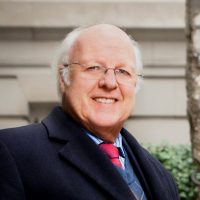
From the AGI Bookshelf: Black Earth: The Holocaust as History and Warning

Jackson Janes
President Emeritus of AGI
Jackson Janes is the President Emeritus of the American-German Institute at the Johns Hopkins University in Washington, DC, where he has been affiliated since 1989.
Dr. Janes has been engaged in German-American affairs in numerous capacities over many years. He has studied and taught in German universities in Freiburg, Giessen and Tübingen. He was the Director of the German-American Institute in Tübingen (1977-1980) and then directed the European office of The German Marshall Fund of the United States in Bonn (1980-1985). Before joining AICGS, he served as Director of Program Development at the University Center for International Studies at the University of Pittsburgh (1986-1988). He was also Chair of the German Speaking Areas in Europe Program at the Foreign Service Institute in Washington, DC, from 1999-2000 and is Honorary President of the International Association for the Study of German Politics .
Dr. Janes is a member of the Council on Foreign Relations, the International Institute for Strategic Studies, the Atlantic Council of the United States, and American Purpose. He serves on the advisory boards of the Berlin office of the American Jewish Committee, and the Beirat der Zeitschrift für Außen- und Sicherheitspolitik (ZfAS). He serves on the Selection Committee for the Bundeskanzler Fellowships for the Alexander von Humboldt Foundation.
Dr. Janes has lectured throughout Europe and the United States and has published extensively on issues dealing with Germany, German-American relations, and transatlantic affairs. In addition to regular commentary given to European and American news radio, he has appeared on CBS, CNN, C-SPAN, PBS, CBC, and is a frequent commentator on German television. Dr. Janes is listed in Who’s Who in America and Who’s Who in Education.
In 2005, Dr. Janes was awarded the Officer’s Cross of the Order of Merit of the Federal Republic of Germany, Germany’s highest civilian award.
Education:
Ph.D., International Relations, Claremont Graduate School, Claremont, California
M.A., Divinity School, University of Chicago
B.A., Sociology, Colgate University
Expertise:
Transatlantic relations, German-American relations, domestic German politics, German-EU relations, transatlantic affairs.
__
Timothy Snyder’s latest book, Black Earth: The Holocaust as History and Warning, presents exactly those two narratives. His review of how the Holocaust emerged and evolved has been and remains the subject not only of Snyder’s earlier work, but also of volumes of research, which will never run out of time or need. In his approach to explaining the Holocaust, Snyder has focused on a model of analysis that may lessen the preoccupation with the uniqueness of the Holocaust and expand the space devoted to grasping Hitler’s—and Stalin’s—views of both their goals and their methods to achieve them. Snyder spends the larger part of the book explaining how the eradication of Jews stemmed from Hitler’s belief in racial, ethnic, and hence global purity, which could only be achieved through a zero-sum result: the end of all Jewish influence in the world ecosystem. In order to accomplish that goal, his path toward the Holocaust required the elimination of states and the expansion of German Lebensraum. Only by creating such stateless conditions could Hitler carry out the Holocaust. That it was to be done first in cooperation with—followed by a war with—Stalin was part of the Nazi strategy. The black earth on which the Holocaust would be primarily carried out was to be among those stateless territories. Hitler’s ultimate defeat was then in part caused by the failure to achieve sufficient Lebensraum to carry out the diabolical plan.
Looking back on this assessment, Snyder turns his last chapter to the present, warning of the dangers inherent in the evolution of theories that echo those of the Nazi legacy. Snyder reviews examples of how attributing the wrong factors to the lessons of the all-powerful state of Hitler’s empire can lead to similar disasters decades after 1945. His examination of several different cases—the U.S. in Iraq, China’s stability in terms of its food resources, Africa’s stability amid civil and ethnic wars, and Russia’s efforts to extend its regional power—derives from a false sense of certainty of the sources of danger and solutions to threats. As Snyder points out, the deduction of certainty takes a dangerous course:
“Since the world is more complex than a country or city, the temptation is all the greater to find some master key to understanding everything. When a global order collapses, as was the experience of many Europeans in the second, third, and fourth decades of the twentieth century, simplistic diagnosis such as Hitler’s can seem to clarify the global by referring to the ecological, the supernatural, or the conspiratorial. […] One apparentsolution is to define the global enemy.” (p. 327)
Hitler had designated that the enemy was the Jews; but Snyder suggests that today the perceived enemy can be supplemented by other target groups associated with global changes.
He concludes his warnings by reminding us of the need to maintain a balance of what he calls pluralities or plural structure:
“One plurality is between politics and science. A recognition of their distinct purposes makes possible thinking about rights and states; their conflation is a step toward a total ideology such as National Socialism. Another plurality is between order and freedom: each depends upon the other, although each is different from the other. […] The point of politics is to keep multiple and irreducible goods in play, rather than yielding to some dream, Nazi or otherwise, of totality.”(p. 340)
Linking up the historical side of this major work with the philosophical conclusion is a challenge for readers. But Snyder would suggest that to understand the full legacy of the Holocaust is to “preserve humanity. […] The answer to those who seek totality is not anarchy, which is not totality’s enemy but its handmaiden. The answer is thoughtful, plural institutions: an unending labor of differentiated creation. This is a matter of imagination, maturity, and survival.” (p. 342)
That work goes on.









